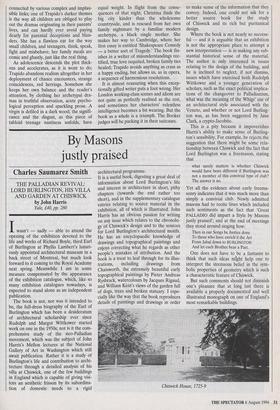By Masons justly praised
Charles Saumarez Smith
THE PALLADIAN REVIVAL: LORD BURLINGTON, HIS VILLA AND GARDEN AT CHISWICK by John Harris Yale, £40, pp. 280 Iwasn't — sadly — able to attend the opening of the exhibition devoted to the life and works of Richard Boyle, third Earl of Burlington at Phyllis Lambert's luxuri- ously appointed architectural museum in a back street of Montreal, but much look forward to it coming to the Royal Academy next spring. Meanwhile I am in some measure compensated by the appearance of the exhibition catalogue, which, like so many exhibition catalogues nowadays, is expected to stand alone as an independent publication.
The book is not, nor was it intended to be, the full-dress biography of the Earl of Burlington which has been a desideratum of architectural scholarship ever since Rudolph and Margot Wittkower started work on one in the 1950s; nor is it the com- prehensive study of the neo-Palladian movement, which was the subject of John Harris's Mellon lectures at the National Gallery of Art in Washington which still await publication. Rather it is a study of Burlington's life and contribution to archi- tecture through a detailed analysis of his villa at Chiswick, one of the few buildings in England which is capable of giving visi- tors an aesthetic frisson by its subordina- tion of domestic needs to a rigid architectural programme It is a useful book, digesting a great deal of information about Lord Burlington's life and interest in architecture in short, pithy chapters (towards the end rather too short), and in the supplementary catalogue entries relating to source material in the exhibition, all of which is illustrated. John Harris has an obvious passion for writing on any issue which relates to the chronolo- gy of Chiswick's design and to the sources for Lord Burlington's architectural motifs. He has an encyclopaedic knowledge of drawings and topographical paintings and enjoys correcting what he regards as other people's mistakes of attribution. And the book is a treat to leaf through for its illus- trations, including drawings from Chatsworth, the extremely beautiful early topographical paintings by Pieter Andreas Rysbrack, watercolours by Jacques Rigaud, and William Kent's views of the garden full of dogs, trees and broken statuary. I espe- cially like the way that the book reproduces details of paintings and drawings in order to make sense of the information that they convey. Indeed, one could not ask for a better source book for the study of Chiswick and its rich but puritanical design.
Where the book is not nearly so success- ful — and it is arguable that an exhibition is not the appropriate place to attempt a new interpretation — is in making any sub- stantial historical sense of the material. The author is only interested in issues relating to the design of the building, and he is inclined to neglect, if not dismiss, issues which have exercised both Rudolph Wittkower and a younger generation of scholars, such as the exact political implica- tions of the changeover to Palladianism, what was the meaning of the Whigs' use of an architectural style associated with the Veneto, and whether or not Lord Burling- ton was, as has been suggested by Jane Clark, a crypto-Jacobite.
This is a pity because it impoverishes Harris's ability to make sense of Burling- ton's sensibility. For example, he rejects the suggestion that there might be some rela- tionship between Chiswick and the fact that Lord Burlington was a freemason, stating that what surely matters is whether Chiswick would have been different if Burlington was not a member of this convivial type of club? The answer is no.
Yet all the evidence about early freema- sonry indicates that it was much more than simply a convivial club. Newly admitted masons had to recite lines which included such sentiments as the fact that 'Great PALLADIO did impart a Style by Masons justly praised'; and at the end of meetings they stood around singing how: Then in our Songs be Justice done To those who have enrich'd the Art From Jabal down to BURLINGTON And let each Brother bear a Part.
One does not have to be a fantasist to think that such ideas might help one to interpret the strenuous belief in the sym- bolic properties of geometry which is such a characteristic feature of Chiswick.
But such comments should not diminish one's pleasure that at long last there is available a properly documented and well illustrated monograph on one of England's most remarkable buildings.
Chiswick House, 1725-9


















































 Previous page
Previous page